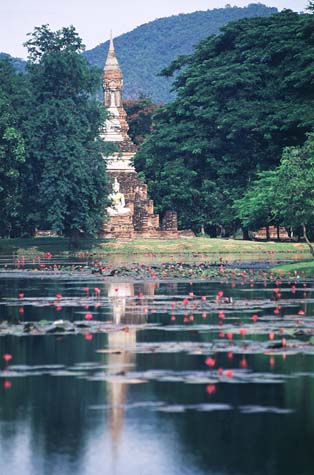

for the Thai language
 |  | Internet resource for the Thai language |
F.A.Q. Check out the list of frequently asked questions for a quick answer to your inquiry
recent donations!
Sign-up to join our mailing list. You'll receive email notification when this site is updated. Your privacy is guaranteed; this list is not sold, shared, or used for any other purpose. Click here for more information.
To unsubscribe, click here.
gallery home prev photo next photo
 The walled city of Sukothai was the capital of Thailand from 1230 until Ayutthaya gained prominence in around 1440. Khmers began
the city, but they abandoned Sukothai as the Khmer Empire, based at Angkor (in modern Cambodia), waned. The Thais took over and
added to the city, beginning the brilliant but short Sukothai period. In 1292, King Ramkamhaeng recorded the achievements of this
society on a stone monolith, which can be seen in the National Museum in Bangkok; a replica can be found at Sukothai.
The walled city of Sukothai was the capital of Thailand from 1230 until Ayutthaya gained prominence in around 1440. Khmers began
the city, but they abandoned Sukothai as the Khmer Empire, based at Angkor (in modern Cambodia), waned. The Thais took over and
added to the city, beginning the brilliant but short Sukothai period. In 1292, King Ramkamhaeng recorded the achievements of this
society on a stone monolith, which can be seen in the National Museum in Bangkok; a replica can be found at Sukothai.This photo shows Wat Trapang Ngoen, which consists of a lotus-bud shaped chedi fronted by a seated Buddha image which would have been housed in a building (viharn) which is no longer present because it was likely made of timber. The square base and shape of the chedi are influenced by Sri Lanka style, while a walking Buddha image carved on the spire (which cannot be made out in this image but is visible on the Fujichrome/Velvia slide) is a distinctly Sukothai innovation. Sukothai Historical Park is a remarkable and important destination for visitors to Thailand, but it is not visited by most tourists since there is generally less infrastructure in Central Thailand. Bangkok Airways has now begun flights to Sukothai, which may remedy this situation. |